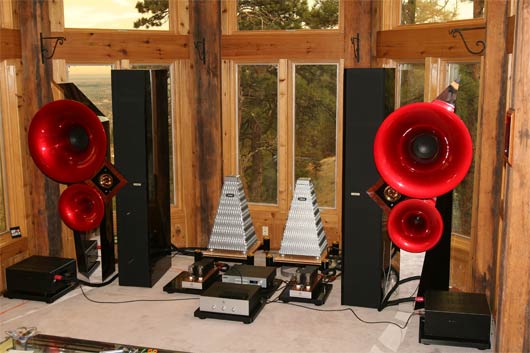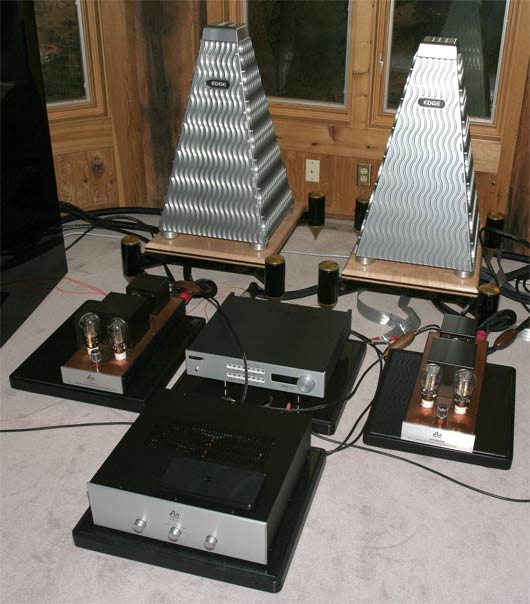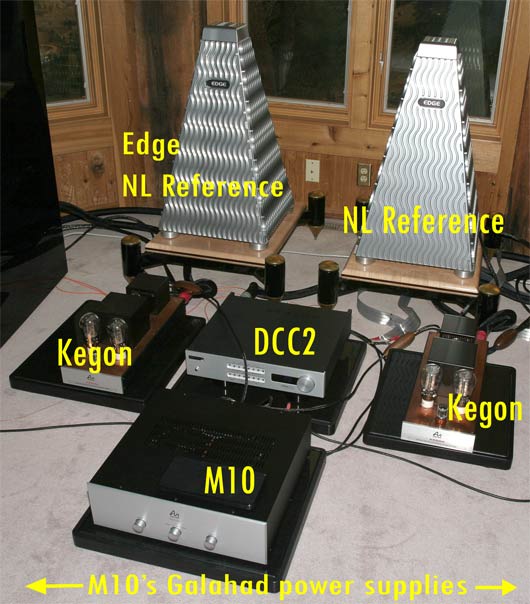We took a highly optimized system this week and compared the Meitner CDSD transport / DCC2 DAC, both Signature Editions
against the
Audio Note CDT3 transport and DAC 4.1x Balanced
The price of these two combos is approximately the same, about $22K.
This is the test system:

Acapella Triolon Excalibur, Audio Note Kegon 300B SET amplifiers, Audio Note M10 linestage, Jorma Design Prime single-ended interconnects and Jorma Design Prime bi-wire speaker cable on the midrange horns, Jorma Design No. 1 speaker cable on the bass towers / plasma tweeters. All platforms and power supplies on HRS M3 Isolation Bases. Power cords all Shunyata Anaconda, either Alpha or Vx or Helix alpha or Helix Vx.
Just for grins, I added it up and this is about a $350K system [without the Edge NL Reference amps].
Sounds like it too.

The Emm Labs-based system.

The Audio Note-based system
In the Emm Labs corner the advantages were that they had been on two or three days – so they were wamred up and settled in.
The disadvantages during this test were that the M10 linestage is not yet broken-in, and the M10’s stiffness and inability to relax at its current age (about 5 weeks) plays against the weakness of any solid-state digital source: that is being a little too analytical.
In the Audio Note corner the advantages were that the rest of the components were Audio Note components, and this is one of the few product lines in the world where components from a single manufacturer actually enhance each-others performance.
The disadvantages of the Audio Note in this test were that they had only been on between one and two hours. Also the transport was by necessity nearly in front of one of the bass towers (the big, HEAVYYYY Edge Reference amps got trapped behind all the components early on during the recent marathon audition performaed on this system, which kind of pushed all the other components out into the room farther than is normally the case).
The Audio Note DAC 4.1x Balanced is a stock piece of equipment – no tubes were rolled to enhance performance.
OK. There really weren’t any surprises during this shootout.
I know, BOR-ing.
But I think it was still interesting because it was illustrative of the struggle that occurs in all systems: between organic sound and resolution, between Naturalness and Realness.

This system with the Emm Labs, and with the assorted ontourage, was HIGHLY resolving, both in spaced and in time. After a number of experiments, I am willing to conjecture in public 🙂 that it is the Jorma Prime that added the ability to resolve things in space to such a high degree, and the M10 handled the resolution in Time.
VERY highly resolving – note envelopes started, stopped, rose, fell, pulsated, swelled, burped and groaned just like they should – EXACTLY like they should.
Notes were placed in 3D exactly where the engineer wanted them to be placed – and new insight was gained about how these guys, and hopefully gals, often play with the knobs on sound boards just a bit too casually, let’s say – often distracting the mind of the listener a little too much like people who use too many fonts on a single page [hey, we really TRY to keep it to two or three fonts around here. Really].
The bass was amazingly tight compared to what we are used to on these speakers (the addition of the M10 added the ability to milk everything from the Meitner in this respect).
[Just to be clear – this is a big sound, resolving on a relative basis and in proportion to all of the frequencies from say 28Hz to 50K Hz. It does NOT mean resolution in the sense of the pyrotechnic wonders that shove unwanted details of the leading edges of notes from 1K Hz to 3KHz eschewing true resolution in either space or time for a quick slamm-bamm-thank-you Impressiveness.]
Any weaknesses to this system, which was probably one of the crowning achievements in home audio at this time?
This is more of a psychological thing, and a system is not usually all one of the other, having to do with how much a person has to focus, and some might say even concentrate, on the sound before they are sucked in. Of course, a system has to be at least pretty darn good if it can suck a person in at all with any kind of reliability.
In your home, late at night, with the lights low and a glass (or bottle 🙂 ) of wine, if you do not get sucked in, then your system has Problems. Conversely, if you are at an audition at a high-end audio dealership, somewhat uncomfortable, hearing unfamilair music and trying NOT to forget that you have an appointment with a dentist in a few hours – then if you get sucked in – that system has to be Mighty Fine!
Anyway, the only weakness that this system had, in either conventional or unconventional sense, was that it took a little more relaxation and focus to get ‘sucked in’ and absorbed by the music than one might hope. Once ‘Absorbed’ , it was a heck of a ride, often resulting in mouths hanging open in a kind of slow motion ‘ooooooh, THIS is what it was like to be there when this song was recorded’.

OK. Switching to the Audio Note digital.
Well, this took care of the Absorbtion Factor. Very natural sounding and engaging.
Perhaps even better solidity in the soundstage. Striking even.
But, as you all probably expect – there was less resolution – the leading and trailing edges of the notes were not as well defined – although the bass notes were noticably tighter after two hours of warm up playing a a few CDs.
OK, here is where I am going with this.
We, and I presume most of you, want something right SMACK inbetween these two sounds. We want the best of both worlds (hey, why not? 🙂 )
We want the sound to sound Real, or actually Realer than Real, since Real has problems and why bring THAT baggage into our system if we do not have to. And we want it to be so engaging, so absorbing – so much magnetism that it physically stops us in our tracks and we must struggle to find our way to the closest chair so we can not have to waste brain cycles with standing up – having to be reminded every once in a while to BREATHE [I am sure we have all been struck breathless by our systems – who says audiophiles don;t live on the edge?]
And, what I want to say here, is that I think BOTH of these digital sources, on this system, can walk this line between Ultimate Resolution and Ultimate Absorption (or Magnetism).
As the M10 breaks in the Meitner-based system will evolve to be more Absorptive – it is already like a bear trap, ready to spring upon the unwary listener if they give it a seconds notice.
And as the Audio Note-based system warms up, moving the transport away from in front of the bass towers 🙁 and perhaps even rolling a tube or two – the resolution will match that of the solid-state solution. Why do I beleive this? Because the Kegon and M10 both have the resolution of, if not more in many senses, of solid-state gear.
OK, so with some work they can sound alike? If that were true (and I predict it is true to a high degree, to the point where one must carefully define ‘alike’ to tell them apart) then how to choose between them if one must have one or the other for their system?
It is by knowing one’s preferences – that when one of these solutions is NOT optimized, is the sound still going to be acceptible? Can one live with a little less resolution or is it better to have a little less ‘Reach Out and Grab Ya’ (and this may very well be system dependent – especially if the rest of the system is not well-balanced in this respect).
Well, that was long. Hopefully it was helpful, or interesting, or…at least illuminating of the real dilemnas one faces when optimizing systems – we are always striving for that balance, that knife edge, where Everything Wonderful Happens At Once, during Each Note, Every Song, Every Album, Every Day.
